Research Article | Vol. 5, Issue 3 | Journal of Clinical Medical Research | Open Access |
Cardiac Pacemaker and the Effect on Hemodynamics of the Tricuspid Valve
Haydar Moahammad1,2,3*




1Internal Department C, Laniado Medical Center, Netanya, Israel
2Cardiology Department, Bnai-Zion Medical Center, Haifa, Israeel
3Adelson School of Medicine at Ariel University, Israel
*Correspondence author: Mohammad Haydar, MD, Specialist Physician of Internal Medicine, Laniado Medical Center Netanya, Israel; Email: [email protected]; [email protected]
Citation: Haydar M, et al. Cardiac Pacemaker and the Effect on Hemodynamics of the Tricuspid Valve. Jour Clin Med Res. 2024;5(3):1-10.
Copyright© 2024 by Haydar M, et al. All rights reserved. This is an open access article distributed under the terms of the Creative Commons Attribution License, which permits unrestricted use, distribution, and reproduction in any medium, provided the original author and source are credited.
| Received 13 August, 2024 | Accepted 02 September, 2024 | Published 09 September, 2024 |
Abstract
Placement of ICDs, permanent pacemakers and biventricular devices is performed under fluoroscopic guidance. Implantable device leads can cause Tricuspid Regurgitation (TR) when they interfere with leaflet motion. In our clinical experience, we had two cases where patients with endocardial right ventricle leads developed severe TR. One patient was treated by having his leads repositioned and the other required surgery. This study analyzed the grade of tricuspid regurgitation before and after implantation of lead pacmencker in Right Ventrecle.
Aim: Evaluation of tricuspid regurgitation after right ventricular permanent lead implantation to check if echocardiographic guidance is needed for adequate lead positioning.
Methods: 76 patients had trans-thoracic Doppler echocardiographic studies before and after implantation of permanent right ventricular leads.
Results: Before Right Ventricular (RV) lead implantation, 96% of patients had Tricuspid Regurgitation (TR). Patients were stratified by grade of regurgitation. 57 patients were grade 1 (75%), 12 (16%) were grade 2 and 4 were grade 3 or 4 (5%). After RV lead implantation, 44 patients with grade 1 TR remained with the same degree (77%) while in 2 (3.5%) TR progressed to grade 2 and in the remainder the TR disappeared.
Most of the patients with grade 2 TR before RV lead implantation (75%) remained in grade 2 while 25% the grade decreased to grade 1.
In all the patients with grade 3 and 4 TR pre-implantation, the severity of TR decreased by one grade.
In 56 patients with non-CRT device implantations, 39 (70%) had grade 1 TR before procedure. After implantation, 28 (72%) of them did not change grade and 11 (28%) progressed to grade 2. Regarding grade 2 TR before implantation in 8 patients (14%) – the TR grade decreased in 3 (37.5%) and did not change in the others. In 3 (5.4%) patients with grade 3 and 4 TR before the procedure, the TR decreased after procedure.
Conclusion: Implantation of permanent RV leads did not worsen TR grade.
Keywords: Cardiac Pacemaker; Right Ventricular; Tricuspid Regurgitation; Implantable Cardiac Defibrillators
Introduction
For the last few years, there have been a significant increase in the number of implantable cardiac devices such as Permanent Pacemakers (PPM), Implantable Cardiac Defibrillators (ICD) and Biventricular pacemakers (BiV) worldwide [1-3]. Implantation of these devices significantly reduced cardiac morbidity and mortality [4-5]. However, these interventions are not without complications. Interactions between Right Ventricular (RV) electrodes and valve structures are associated with exacerbation of Tricuspid Regurgitation (TR).
This may be due to a mechanical cause such as the formation of scar tissue or thrombus on the leads that impair the closing of the valve leaves. For example, a perforation or rupture of the valve leaflets may trigger the development TR. Another mechanism for the formation of TR is asynchrony, which results from abnormal activation of the RV by a cardiac pacemaker. It’s important to note that it may resolve if the patient returns to his internal sinus rhythm [7,8]. Kim, et al., demonstrated that TR after ICD or Permanent Pacemaker (PPM) implantation is not associated with an increase in pulmonary arterial pressure (Fig. 1) [9].
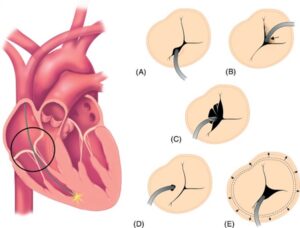
Figure 1: Mechanisms of mechanical tricuspid regurgitation in the setting of permanent pacemaker or implantable cardioverter-defibrillator leads. (a) Valve obstruction caused by lead placed in between leaflets; (b) Lead adherence due to fibrosis and scar formation to valve causing incomplete closure; (c) Lead entrapment in the tricuspid valve apparatus; (d) Valve perforation or laceration; (e) Annular dilatation.
Previous studies and postmortems in the 1970s demonstrated that the leads for pacemakers may attach to the leaflets of the tricuspid valve and even more frequently to the papillary muscles. Over time, holes or tears usually developed on the back leaflet. Regarding TR that develops years after PPM implantation – Iskandar, et al., claim that adhesion of the Tricuspid Valve (TV) leaflets to the pacemaker electrodes obstructs leaflet movement and thereby causes an unsynchronized motion of the posterior leaflet with the septal and anterior leaflets. It is further claimed that already 12 hours after the procedure, the formation of a neo-endocardium is observed, with the development of fibrous sheaths around the leads, resulting in multiple endocardial connections. Fibrosis tissue and adhesions that are subsequently formed may affect valve function. A thin layer of fibrin begins to develop around the pacemaker wiring shortly after electrode implantation has been observed.
A study by Huang, et al., found that lead thrombosis often occurs within 4-5 days after cardiac lead implantation, which may result in acute TR [28]. As previously described, the frequency of acute TR varies in many published studies [40]. While several small studies (mostly retrospective), case reports and reviews have suggested that permanent endocardial electrode implantation can lead to Tricuspid valve disorder (TR) [15-16], other studies have not demonstrated any relationship between the implantation of the device and the development of TR [17].
In addition, the effect of CRT therapy on the development of TR after device implantation has not been defined. Furthermore, patients undergoing ablation for atrial and ventricular arrhythmias routinely undergo temporary pacemaker lead insertion, often using multiple leads that cross the tricuspid valve [18-19]. However, very little is known about the effects of temporary electrode insertion on TR severity in these patients [20]. Left Bundle Branch Block (LBBB) is a common finding in heart failure situations with decreased left ventricular function and is accompanied by increased morbidity and mortality [21]. One third of patients with heart failure have LBBB which may cause desynchronization of left ventricular contraction and thus worsening of the heart failure [22,23]. At the same time, the effect of LBBB on right ventricular function is not sufficiently known and there is a debate regarding the extent of the effect of resynchronization therapy on improving right ventricular function [24-28]. It is known that right ventricular function is an independent predictor for the response to treatment by CRT, which can indicate that there is an interaction between CRT and right ventricular function [29]. The function of the left ventricle may affect the function of the right ventricle through the pulmonary circulation and also through the interventricular interaction [30-31]. In the presence of LBBB, there is a disturbance in the contraction of the interventricular septum with early systole shortening and movement to the left [32-33] and then lengthening and movement to the right of the septum will appear [34- 35]. This mobility of the septum may affect the function of the right ventricle [36-37]. The traditional grading of tricuspid regurgitation severity focuses on color Doppler ultrasound imaging. Reliance on jet size and Right Atrial (RA) dilation depends on several technical and hemodynamic factors.
- Vena contracta width is the recommended parameter in TR severity grading, where ≥7 mm is indicative of severe TR.
- Quantitative Proximal Iso-Velocity Surface Area (PISA) method (also known as flow convergence method) is possible, but less often used, where severe TR is defined as an Effective Regurgitant Orifice (EROA) ≥40 mm2 with a regurgitant volume of ≥45 ml.
Tricuspid regurgitation defined as EROA with a cut-off ≥ 40 mm2 was found to be associated with increased mortality and morbidity for 10 years according to previous works (Fig. 2) [48].

Figure 2: Selection of tricuspid valve regurgitation parameters. (A) Is a 3D colour flow full-volume acquisition of severe TR and demonstrates the flow convergence, vena contracta and jet expansion upwards into the RA (left image) and the en face view of the flow convergence viewed from the RV aspect (right image). The regurgitant orifice is an irregular elliptical shape; (B) Continuous wave Doppler profile of severe tricuspid regurgitation, demonstrating a triangular low velocity jet. In this setting, estimation of RV systolic pressures will be underestimated due to rapid pressure equalization between RA and RV; (C) Depicts systolic flow reversal, seen in severe tricuspid regurgitation, during hepatic vein flow interrogation; (D) 3D echo format, X-plane, where orthogonal planes in 2D are imaged simultaneously. The vena contracta (red arrows) is longer in the left view and highlights an elliptical regurgitant orifice, confirming the findings in image A; (E) Shows multiplane reconstruction format of the 3D vena contracta and measurement of the vena contracta area and demonstrates massive TR VC area 95 mm2. VC, vena contracta.
Research Hypothesis
Since RV function and the severity of TR are predictors of morbidity and mortality, it is very important to evaluate the effect of the different types of pacing on RV function and TR severity in order to choose the optimal pacing method for a patient.
Method and Materials
Research Setup
This study is a retrospective analytical study. Data about each of the subjects in this study was collected from the medical files of the patient population, including the echocardiographic indices before and after the implantation of the cardiac device. We checked the data of 76 patients in an anonymous form and coded according to serial number (the coding list was then eliminated). A comparison was made of the echocardiography and Doppler data before and after pacing, as well as a comparison between the different types of pacing.
Statistical Methods
The continuous measures were presented as mean and standard deviation. Discontinuous values were presented as numbers and/or percentages. Student-t-test (?) was used to compare the continuous values and chi-square test was used between the non-continuous parameters. An ANOVA statistical calculation of the indices was also performed. The correlation coefficients R between the different parameters were calculated. A value of P<0.05 is considered statistically significant.
Ethical Aspects
In addition to the approval of the ethics committee at the hospital, the operations and tests performed on patients were non-invasive, routine, without side effects, without radiation and performed regardless of this current study for all patients.
Ethical Statement
The project did not meet the definition of human subject research under the purview of the IRB according to federal regulations and therefore, was exempt.
The Study Population and Patients’ Data (Fig. 3, Table 1)
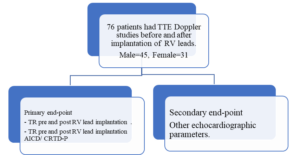
Figure 3: Study population and patients’ data.
Characteristic | |
Age | 11±74 |
Sex | M=45, F=31 |
Smoker | 20 (29%) |
DM | 31 (46.78%) |
HTN | 58 (76.31%) |
HLP | 63 (82.8%) |
COPD/Asthma | 18 (23.68%) |
CVA | 11 (14.47%) |
PVD | 22 (28.94%) |
IHD | 53 (69.73%) |
AFIB | 36 (47.36%) |
Renal Failure | 33 (43.42%) |
AFIB: Atrial Fibrillation, CVA: Cerebrovascular Accident, DM: Diabetes Mellitus, HLP: Hyperlipidemia, HTN: Hypertension, IHD: Ischemic Heart Disease | |
Table 1: Characteristics of the patients.
Variables
Independent Variables
The type of implanted device, the type of pacing (Table 2).
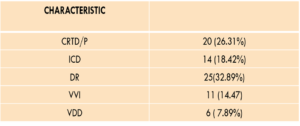
Table 2: Independent variables.
Dependent Variables
Dimensions and function of the right ventricle.
Severity of tricuspid regurgitation.
Dimensions and function of the left ventricle.
Evaluation of MR, TR, AR severity, TAPSE and the change in data after pacing.
Primary End Point
Results:
- Before RV lead implantation 96% of patients had TR, grade 1 in 57 patients (75%), grade 2 in 12 (16%), grade 3 and 4 in 4 (5%)
- After RV lead implantation, 44 patients with grade 1 TR remained with the same degree (77%) while in 2 (3.5%) TR progressed to grade 2 and in the remainder the TR disappeared
- Most of the patients with grade 2 TR before RV lead implantation (75%) remained in grade 2, while in 25% the grade decreased to grade 1
- In all patients with grade 3 and 4 TR pre-implantation, the severity of TR decreased by one grade (Fig. 4-6)
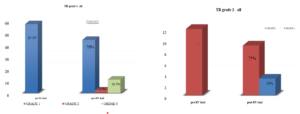
Figure 4: TR grade progression.
- In 56 patients with non-CRT device implantations, 39 (70%) had grade 1 TR before procedure and 28 (72%) of them TR grade did not change and in 11 (28%) TR grade progressed to grade 2 after implantation
- Grade 2 TR before implantation was observed in 8 patients (14%) and after the implantation the TR grade decreased in 3 (37.5%) of them and did not change in the others
- In 3 (5.4%) patients with grade 3 and 4 TR before procedure, the TR decreased after the procedure
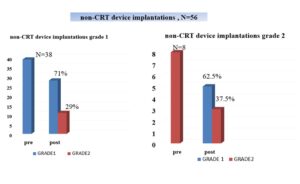
Figure 5: Non-CRT device implantation progression.
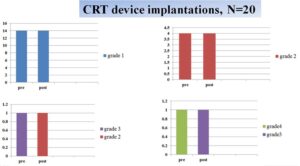
Figure 6: CRT device implantation.
Secondary End Point (Fig. 7)
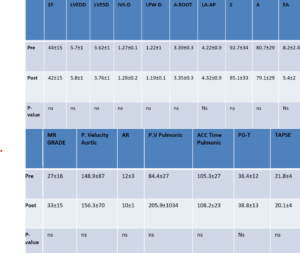
Figure 7: A: mitral A wave late diastolic velocity, E: mitral E wave early diastolic velocity, Ea: mitral annulus wave early diastolic tissue Doppler velocity, EDT: E wave deceleration time, E/A: E to A ratio, E/Ea: E to Ea ratio, LA: left atrium, LA-A: left atrium area, LVEED: left ventricle diastolic diameter, LVEF: left ventricle ejection fraction, LVESD: left ventricle systolic diameter, LPW-D: left posterior wall diameter.
Summary
Cardiac device-related TR is usually due to mechanical injury such as perforation of the valve leaflets, entrapment of leads resulting in scar tissue formation or impaired valve growth. It may also cause physiological alterations like unsynchronized activation of the right ventricle from apex to base.
In this study, we came to the conclusion that implantation of an electrode through the tricuspid valve does not involve worsening of right ventricular function or tricuspid regurgitation. This is demonstrated by the maintenance or reduction in TR grading in all the patients of this study.
However, larger, prospective and well-controlled studies are needed to optimally assess the incidence and timing of TR after endocardial lead implantation.
Conflict of Interests
The authors declare no conflict of interest regarding authorship roles or publication of article.
Consent
Not applicable because this study is based exclusively on published literature.
Disclosure
The authors report no conflicts of interest.
Acknowledgement
None
Financial Disclosure
No funding was not involved in the manuscript writing, editing, approval or decision to publish.
Authors Contribution
All the authors have equal contribution and all the authors have read and agreed to the published version of the manuscript.
Data Availability
Not applicable
References
- Mond HG, Proclemer A. The 11 world survey of cardiac pacing and implantable cardioverter-defibrillators: calendar year 2009:A world society of Arrhythmia’s project. Pacing Clin Electrophysiol. 2011;34:1013-27.
- Kurtz SM, Ochoa JA, Lau E. Implantation trends and patient profiles for pacemakers and implantable cardioverter defibrillators in the United States: 1993-2006. Pacing Clin Electrophysiol. 2010;33(6):705-11.
- Kremers MS, Hammill SC, Berul CI. The national ICD registry report: version 2.1 including leads and pediatrics for years 2010 and 2011. Heart Rhythm. 2013;10:e59-65.
- Al-Bawardy R, Krishnaswamy A, Bhargava M, Dunn J, Wazni O, Tuzcu EM, et al. Tricuspid regurgitation in patients with pacemakers and implantable cardiac defibrillators: a comprehensive review. Clin Cardiol. 2013;36:249-54.
- Zoghbi WA, Adams D, Bonow RO, Enriquez-Sarano M, Foster E, Grayburn PA, et al. Recommendations for noninvasive evaluation of native valvular regurgitation: a report from the American Society of Echocardiography developed in collaboration with the society for cardiovascular magnetic resonance. J Am Soc Echocardiogr. 2017;30:303-71.
- Paniagua D, Aldrich HR, Lieberman EH. Increased prevalence of significant tricuspid regurgitation in patients with transvenous pacemaker leads. Am J Cardiol. 1998;82:1130-2.
- Lin G, Nishimura RA, Connolly HM. Severe symptomatic tricuspid valve regurgitation due to permanent pacemaker or implantable cardioverter-defibrillator leads. J Am Coll Cardiol. 2005;45:1672-5.
- Klutstein M, Balkin J, Butnaru A. Tricuspid incompetence following permanent pacemaker implantation. Pacing Clin Electrophysiol. 2009:32(Suppl 1):S135-7.
- Kim JB, Spevack DM, Tunick PA. The effect of transvenous pacemaker and implantable cardioverter defibrillator lead placement on tricuspid valve function: an observational study. J Am Soc Echo Cardiog. 2008;21:284-7.
- Webster G, Margossian R, Alexander ME. Impact of transvenous ventricular pacing leads on tricuspid regurgitation in pediatric and congenital heart disease patients. J Interv Card Electrophysiol. 2008;21:65-8.
- Mazine A, Bouchard D, Moss E. Transvalvularpacemaker leads increase the recurrence of regurgitation after tricuspidvalve repair. Ann Thorac Surg. 2013;96:816-22.
- Alizadeh A, Sanati HR, Haji-Karimi M. Induction and aggravation of atrioventricular valve regurgitation in the course of chronic right ventricular apical pacing. Europace. 2011;13:1587-90.
- Chen TE, Wang CC, Chern MS. Entrapment of permanent pacemaker lead as the cause of tricuspid regurgitation. Circ J. 2007;71:1169-71.
- Al-Bawardy R, Krishnaswamy A, Bhargava M. Tricuspid regurgitation in patients with pacemakers and implantable cardiac defibrillators: a comprehensive review. Clin Cardiol. 2013;36:249-54.
- Al-Mohaissen MA, Chan KL. Prevalence and mechanism of tricuspid regurgitation following implantation of endocardial leads fo pacemaker or cardioverter-defibrillator. J Am Soc Echocardiogr. 2012;25:245-52.
- Kucukarslan N, Kirilmaz A, Ulusoy E. Tricuspid insufficiency does not increase early after permanent implantation of pacemaker leads. J Card Surg. 2006;21:391-4.
- Leibowitz DW, Rosenheck S, Pollak A. Transvenous pacemaker leads do not worsen tricuspid regurgitation: a prospective echocardiographic study. Cardiol. 2000;93:74-7.
- Spector P, Reynolds MR, Calkins H. Meta-analysis of ablation of atrial flutter and supraventricular tachycardia. Am J Cardiol. 2009;104:671-7.
- Terasawa T, Balk EM, Chung M. Systematic review comparative effectiveness of radiofrequency catheter ablation for atrial fibrillation. Ann Intern Med. 2009;151:191-202.
- Pires LA, Huang SK, Wagshal AB. Clinical utility of routine transthoracic echocardiographic studies after uncomplicated radiofrequency catheter ablation a prospective multicenter study. The Atakr Investigators group. Pacing Clin Electrophysiol. 1996;19:1502-7.
- Baldasseroni S, Opasich C, Gorini M. Left bundle-branch block is associated with increased 1-year sudden and total mortality rate in 5517 outpatients with congestive heart failure: a report from the Italian network on congestive heart failure. Am Heart J. 2002;143:398-405.
- Clark AL, Goode K, Cleland JG. The prevalence and incidence of left bundle branch block in ambulant patients with chronic heart failure. Eur J Heart Fail. 2008;10:696-702.
- Verbeek XA, Vernooy K, Peschar M, Van Der Nagel T, Van Hunnik A, Prinzen FW. Quantification of interventricular asynchrony during LBBB and ventricular pacing. Am J Physiol Heart Circ Physiol. 2002;283:H1370-8.
- Burri H, Domenichini G, Sunthorn H. Right ventricular systolic function and cardiac resynchronization therapy. Europace. 2010;12:389-94.
- Campbell P, Takeuchi M, Bourgoun M. Right ventricular function, pulmonary pressure estimation and clinical outcomes in cardiac resynchronization therapy. Circ Heart Fail. 2013;6:435-42.
- Donal E, Thibault H, Bergerot C. Right ventricular pump function after cardiac resynchronization therapy: a strain imaging study.Arch Cardiovasc Dis. 2008;101:475-84.
- Damy T, Ghio S, Rigby AS, Hittinger L, Jacobs S, Leyva F, et al. Interplay between right ventricular function and cardiac resynchronization therapy: an analysis of the CARE-HF trial (Cardiac Resynchronization–Heart Failure). J Am Coll Cardiol. 2013;61(21):2153-60.
- Bleeker GB, Schalij MJ, Nihoyannopoulos P, Steendijk P, Molhoek SG, van Erven L, et al. Left ventricular dyssynchrony predicts right ventricular remodeling after cardiac resynchronization therapy. J Am Coll Cardiol. 2005;46(12):2264-9.
- Van Everdingen WM, Walmsley J, Cramer MJ. Echocardiographic prediction of cardiac resynchronization therapy response requires analysis of both mechanical dyssynchrony and right ventricular function: a combined analysis of patient data and computer simulations. J Am Soc Echocardiogr. 2017;30:1012-20.
- Haddad F, Doyle R, Murphy DJ, Hunt SA. Right ventricular function in cardiovascular disease, part II: pathophysiology, clinical importance and management of right ventricular failure. Circulation. 2008;117:1717-31.
- Sheehan F, Redington A. The right ventricle: anatomy, physiology and clinical imaging. Heart. 2008;94:1510-15.
- Dillon JC, Chang S, Feigenbaum H. Echocardiographic manifestations of left bundle branch block. Circulation. 1974;49:876-80.
- Little WC, Reeves RC, Arciniegas J, Katholi RE, Rogers EW. Mechanism of abnormal interventricular septal motion during delayed left ventricular activation. Circulation. 1982;65:1486-91.
- Stankovic I, Prinz C, Ciarka A. Long-term outcome after CRT in the presence of mechanical dyssynchrony seen with chronic RV pacing or intrinsic LBBB. JACC Cardiovasc Imaging. 2017;10:1091-9.
- Gjesdal O, Remme EW, Opdahl A. Mechanisms of abnormal systolic motion of the interventricular septum during left bundle-branch block. Circ Cardiovasc Imaging. 2011;4:264-73.
- Szulik M, Tillekaerts M, Vangeel V. Assessment of apical rocking: a new, integrative approach for selection of candidates for cardiac resynchronization therapy. Eur J Echocardiogr. 2010;11:863-9.
- Santamore WP, Dell’Italia LJ. Ventricular interdependence: significant left ventricular contributions to right ventricular systolic function. Progress in Cardiovascular Diseases. 1998;40(4):289-308.
- Champagne J, Poirier P, Dumesnil JG. Permanent pacemaker lead entrapment: role of the transesophageal echocardiography. Pacing Clin Electrophysiol. 2002;25:1131-4.
- Chen TE, Wang CC, Chern MS. Entrapment of permanent pacemaker lead as the cause of tricuspid regurgitation. Circ J. 2007;71:1169-71.
- Iskandar SB, Ann Jackson S, Fahrig S. Tricuspid valve malfunction and ventricular pacemaker lead: case report and review of the literature. Echocardiography. 2006;23:692-7.
Author Info
Haydar Moahammad1,2,3*




1Internal Department C, Laniado Medical Center, Netanya, Israel
2Cardiology Department, Bnai-Zion Medical Center, Haifa, Israeel
3Adelson School of Medicine at Ariel University, Israel
*Correspondence author: Mohammad Haydar, MD, Specialist Physician of Internal Medicine, Laniado Medical Center Netanya, Israel; Email: [email protected]; [email protected]
Copyright
Haydar Moahammad1,2,3*




1Internal Department C, Laniado Medical Center, Netanya, Israel
2Cardiology Department, Bnai-Zion Medical Center, Haifa, Israeel
3Adelson School of Medicine at Ariel University, Israel
*Correspondence author: Mohammad Haydar, MD, Specialist Physician of Internal Medicine, Laniado Medical Center Netanya, Israel; Email: [email protected]; [email protected]
Copyright© 2024 by Haydar M, et al. All rights reserved. This is an open access article distributed under the terms of the Creative Commons Attribution License, which permits unrestricted use, distribution, and reproduction in any medium, provided the original author and source are credited.
Citation
Citation: Haydar M, et al. Cardiac Pacemaker and the Effect on Hemodynamics of the Tricuspid Valve. Jour Clin Med Res. 2024;5(3):1-10.



